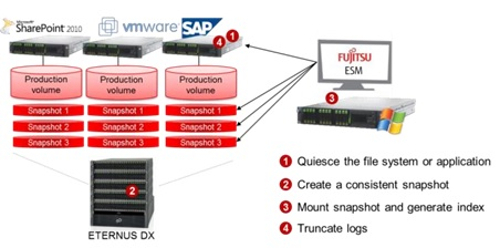ETERNUS Snapshot Manager - an effective tool for high data availability

The constant growth of the data accumulated in the IT infrastructure of a modern enterprise and the stricter requirements for the continuity of business applications greatly complicate the availability of critical information. Today we will talk about a software tool that helps to significantly improve the availability of data - Fujitsu ETERNUS Snapshot Manager.
Traditional tape backup methods are often ineffective due to too low write and read speeds. For example, if a full backup of data is recorded on a weekend, and differential copies are recorded on a night shift, then in the event of a major accident (for example, multiple disk failure), the target data recovery time (RTO) may be more than a day, and the recovery point will be (RPO), which determines the maximum amount of data that can be irretrievably lost if a major storage system crashes, is 24 hours. In addition, in many companies, core business applications work around the clock, so they cannot be stopped overnight or on weekends to back up their data.
In recent years, business-specific data, including backup, has been applied to enterprise-class disk arrays (snapshots) at the level of enterprise-class disk arrays, which provide a snapshot of the state of data stored on an array, at a certain point in time (instant). For example, to obtain a consistent copy of the database, to then back it up without interrupting the work of users. Then, using this snapshot, you can back up the original data without interrupting business applications or use them for other tasks, such as processing data using business intelligence or testing a new version of the application. Unlike classic backup, snapshots allow you to write backups several times a day and as a result, RPO is reduced to several hours. Finally, snapshots are effective for solutions to ensure the resiliency of business applications, such as replication to a remote site.
However, to get the correct snapshot (which you can successfully restore the original data), it is necessary that the “photographed” data is consistent (consistent), for which the application working with them must “freeze” during the generation of the snapshot and suspend all operations from data, i.e. A solution is needed that integrates a snapshot mechanism of a disk array with an application that stores its data on this array.
')

ETERNUS Snapshot Manager main screen
This problem is solved by the ETERNUS Snapshot Manager (ESM Manager) package, which Fujitsu developed on the basis of IntelliSnap, a product released by its strategic partner CommVault, to get data snapshots of its ETERNUS DX disk arrays. The main component of ESM Manager runs on a dedicated server and manages all operations with instant snapshots (snapshot generation schedule, mounting / dismounting and restore operations using snapshots), and ESM Manager agent programs run on productive servers.
In accordance with the generation schedule, the ESM Manager agent “freezes” the necessary file systems and applications, after which ETERNUS DX with its Advanced Copy function very quickly generates a snapshot of their data, which is recorded in a special section of the array. Advanced Copy supports both the creation of a full backup of data (cloning) and the generation of a snapshot of only new (modified) data.

Workflow of ETERNUS Snapshot Manager
1 - freezing file system or application
2 - consistent snapshot record
3 - mount for snapshot and indexing
4 - delete log
Upon completion of the snapshot recording, the file system or applications are “unfrozen” and continue their work again. Next, ESM Manager runs in the background and no longer affects the production system. The package performs a mount operation on the snapshot it just took, indexes it, and creates a detailed directory of the data it contains. Using this directory and index, an administrator can quickly find and restore individual files, volumes or virtual machines, such as Microsoft Exchange mailboxes and individual messages, as needed.
ESM Manager supports all major server operating systems (Windows, Linux / Unix and VMware / Hyper-V) and business applications from Microsoft (Exchange, SharePoint, SQL Server), Oracle and SAP. The use of ESM Manager significantly improves the availability of data from critical applications, providing quick recovery of their data, and simplifies the management and protection of business-critical information, reducing the costs associated with these operations.
Source: https://habr.com/ru/post/304744/
All Articles